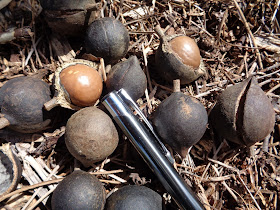Our Demonstration Garden at the East Port Campus on Harbor
View Road in Port Charlotte is a treasure trove of plants. We try all
different types of trees and shrubs at this Demonstration Garden – most are
successful and some get composted. One recent addition was a macadamia
tree. It has been in the garden a few years and this season blessed us
with a few nuts! The macadamia is a beautiful evergreen tree that can be
grown in many parts of Charlotte County. Originally from Australia and
then introduced to Hawaii where it really took root, the macadamia can also be
grown in California and Florida.
Growing up to forty feet tall, macadamia trees have eight
inch long leaves with small spines along the margin edges. The
sweet-scented flowers are white to pink and hang in long racemes over six
inches long. The nut develops within a green husk that eventually
opens up to reveal a hard nut. Once cracked, a white kernel is exposed
which, when roasted, provides one of the best nuts known. There are a couple of
macadamia species (including hybrids) available. Commonly called either
“smooth shell” (Macadamia integrifolia) or “rough shelled” (Macadamia
tetraphylla), macadamias, there are many named cultivars including Hawaiian
and California varieties. ‘Beaumont’ is a noted variety that is good for
backyard plantings. While seeds can be sprouted, it will take upwards to
twelve years to produce a crop. Therefore, it is best to obtain grafted
varieties which will begin to produce in as little as two to five years.
In perfect situations, a mature tree could produce upwards of one-hundred and
fifty pounds of nuts in the shell. This of course does not take into
account the realities of pesky squirrels and rats. Expect the nuts to be
ripe anywhere from July through November. Ripe nuts will fall to ground.
As the nuts dry, you will notice that the husk will split open exposing the nut
inside. The nuts are mechanically cracked, allowed to dry and then
roasted at two-hundred and seventy-five degrees Fahrenheit either dry roasted
or with some refined coconut oil for twelve to fifteen minutes.
Macadamias do best in full sun and in well-drained
soil. While they can survive in our subtropical climate, mature trees can
tolerate temperatures as low as twenty-five degrees Fahrenheit. Young
trees need protection as they can be killed by freezing
temperatures. Once established, macadamia are fairly
drought-tolerant but will appreciate irrigation during flowering and
fruiting. Fertilize with a citrus-type fertilizer as per label
directions.
Now, our small success is encouraging, but macadamia nut
trees are not without their challenges. However, as many gardeners could
agree, new additions – even the macadamia - could make an interesting and
potentially tasty addition to your landscape! For more information on all
types of subtropical edible plants suitable for our area, please call our
Master Gardener volunteers on the Plant Lifeline on Mondays, Wednesdays and
Fridays from 1 to 4 pm at 764-4340 for gardening help and insight into their
role as an Extension volunteer. Don't forget to visit our other County
Plant Clinics in the area. Please check this link for a complete list of
site locations, dates and times - http://charlotte.ifas.ufl.edu/horticulture/Plant%20Clinics%20Schedule.pdf.
Resources:
Malo, S. E. & Campbell, C. W. (2009) The
Macadamia. The University of Florida Extension Service, IFAS.
California Rare Fruit Growers, Inc. (1997) Macadamia. http://www.crfg.org/pubs/ff/macadamia.html
.


No comments:
Post a Comment